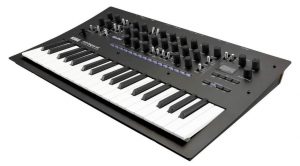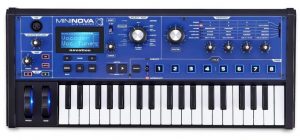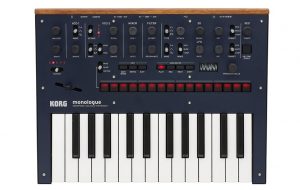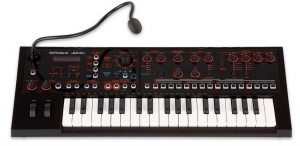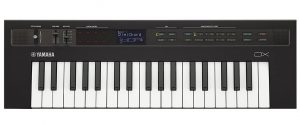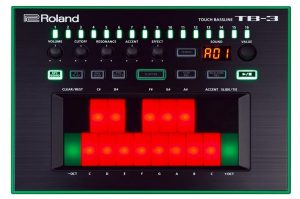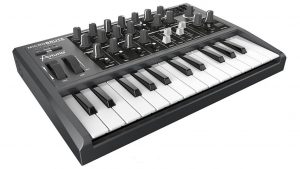Music enthusiasts and professional keep mixing music to create professionally sounding sounds and the synthesizers makes it easy for them to do so as they are packed with all the desired tools to help in professional music mixing. They share the same keyboard style layout as that of the piano, but they render a myriad of opportunities for sound creation. These are the best synthesizers for beginners, as it encompasses many different sound types, be it a smooth sine wave to a harsh tune.
Quick Summary: Synthesizers for Beginners
Also check: Top 5 Best Budget Synths Under $500
Table of Contents
- Quick Summary: Synthesizers for Beginners
- Top 7 Best Synthesizers for Beginners
- #1. Korg MINILOGUEXD Synthesizer – Best Overall
- #2. Novation AMS-MiniNova Analog Synthesizer – Runner Up
- #3. Korg Monologue Monophonic Analog Synthesizer – Editor’s Choice
- #4. Roland JD-XI Analog-Digital Crossover Synthesizer – Popular in Market
- #5. Yamaha Reface DX Portable FM Synthesizer – Great Brand Value
- #6. Roland TB-3 Touch Bassline Synthesizer – Easy to Play
- #7. Arturia MicroBrute Analog Synthesizer – Ideal for Learners
- Beginners Guide to Buying the Best Synthesizer
- What are the types of synths?
- What are the benefits of a synthesizer?
- Who can use a synthesizer?
- What are the alternatives to a synthesizer?
- Best brands of a synthesizer?
- Recommendation
- Final Words
- Frequently Asked Questions (FAQs)
- You Might Also Like:
Top 7 Best Synthesizers for Beginners
Getting the first synth is a big step for beginners. To help you get started with the best instrument at hand, we have compiled the list of the top 7 best synths for beginners from the leading brands of the world.
#1. Korg MINILOGUEXD Synthesizer – Best Overall
| Features | Rating |
| Performance and sounds | 9.2 |
| Connectivity | 8.8 |
| Build Quality | 8.8 |
| Easy to Use | 8.9 |
| Value for money | 9.2 |
This is an excellent analog synthesizer circuit that offers four-voice polyphonic analog synthesis. The analog synthesizer circuit renders genuine analog sounds that render excellent impact over the synth world. The synthesizer has been developed further with the help of the mini lodge XD. The synthesizer features 37 slim keys that are slim and are velocity-sensitive.
Its analog sound generator features multi-digital sounds and maximum polyphony. There are four voice programs in this synthesizer with around 500 voices, which includes more than 300 user programs and 200 preload sounds. Each of the programs renders a program that includes a range of voice mode settings as well.
Each of the programs in this synthesizer has a program sort function wherein we can alter the voice mode settings. Four built-in voice modes include unison, poly, chord, and arp. The voice mode depth setting helps us to set different parameters that are to be varied for each mode.
There are many effects available in this synthesizer as it features a unique multi-engine. Its noise generators, oscillators, and mod effects are creating the best sounds that include chorus, ensemble, flanger, phasers, etc. There are 16 slots for delays, eight slots for reverts, and joystick controls that are capable of modifying different parameters for each of the programs in this synthesizer. Its real-time OLD oscilloscope providers excellent visual feedback with its six-digit LED display and the device is powered by an AC adapter for the ongoing experience.
Pros
- This is an excellent analog synthesizer with 500 presets and patches
- This is an excellent polysynth unit that is available at an affordable cost
- Excellent synthesizer for novice players
Cons
- The keys of this synthesizer are not of full size
- This doesn’t come with a carry bag.
Also check: Top 5 Best Synths for Ambient Music
#2. Novation AMS-MiniNova Analog Synthesizer – Runner Up
| Features | Rating |
| Performance and sounds | 9.1 |
| Connectivity | 8.8 |
| Build Quality | 9.1 |
| Easy to Use | 8.7 |
| Value for money | 9.3 |
This is an ideal synthesizer for the novice player and it features a powerful mini-synth with a nova sound engine. It features a vocoder with a unique vocal tune and sound pitch correcting effect. Its tweak and warp sounds are excellent and are possible in real-time. This synthesizer has 256 awesome onboard sounds and also comes with an additional free sound pack that we can download upon registration, along with the 30 Giorgio Moroder-inspired patches.
With this synthesizer, it is possible to layer up to 5 effects per voice and it also comes with a three years’ product warranty. The MiniNova by Novation is a compact and super-cool studio and live synth that shares the same sound engine as that of the Ultra Nova. Its features about 256 excellent onboard sounds that we can tweak with the help of its knobs. It features up to 18 voices and five synth effects on every single sound.
As it encompasses an onboard vocal tune effect and a classic vocoder, it is possible to recreate iconic vocal sounds from urban, hip hop, and also electronic music.
It is editing software that is included helps with powerful synth and this software offers access to the synth engine and works with any DAW and music software. There are about 256 onboard sounds and space to add 128 new sounds in this synthesizer. In short, this is an excellent keyboard with a lot of power for its price.
Pros
- Features brand new VocalTune and classic vocoder effects
- The synthesizer has an extremely powerful sound engine and synth effects
- Comes with an instant editing and performance control option
- It is possible to tweak and warp the sounds in real-time.
Cons
- There is no sequencer onboard.
Must check: Best Synths for Hip Hop: Top 5 Picks
#3. Korg Monologue Monophonic Analog Synthesizer – Editor’s Choice
| Features | Rating |
| Performance and sounds | 9.2 |
| Connectivity | 8.8 |
| Build Quality | 8.9 |
| Easy to Use | 8.9 |
| Value for money | 9.2 |
This is an excellent synthesizer with an excellent power supply and polishing cloth from Austin Bazaar. This is an excellent synthesizer that comes with all the required accessories to start playing immediately out of the box. The synthesizer comes to use immediately right out of the box and its power supply aids in the process.
This synthesizer looks beautiful and is equally powerful. Its next-generation monophonic analog synthesizer comes in a five-color lineup. This synthesizer is completely programmable and it is truly a next-generation monophonic synthesizer that has a voice of its own. It features a sleek layout and its high-quality construction and knob per function make this the bestselling monologue for novice players.
All new filters drive, modulation and LFO can generate sharp leads and powerful basses to create awesome mono sounds on a single voice design. It is completely programmable and features more than 100 program memories with 80 presets included for the players. Its 16-step sequencer with its extensive motion sequence technology helps to create exceptional sounds within the least time frame possible
Pros
- This is an excellent synthesizer with battery power to substantiate portability.
- Its micro-tuning feature helps in creating alternate tonalities and create scales
- Its oscilloscope function helps in visualizing the waveforms in music in real-time
- An exceptional analog synthesizer that is optimized for exceptional monophonic sounds and sequences.
Cons
- Requires an American to European plug adapter to fit the wall sockets
- The keys are a little small than traditional keys.
Also check: Best Synthesizer Keyboards for Live Performance
#4. Roland JD-XI Analog-Digital Crossover Synthesizer – Popular in Market
| Features | Rating |
| Performance and sounds | 9.2 |
| Connectivity | 8.8 |
| Build Quality | 8.8 |
| Easy to Use | 8.9 |
| Value for money | 9.1 |
This is an excellent and compact synth from Roland that features an exceptional onboard pattern sequencer along with vocal FX. This synthesizer is tiny, mighty, and affordable and features a truly analog sound engine. This synthesizer has supernatural synth sounds and many other creative tools, all under one hood. This music unit is equipped with a series of 37 mini keys and this compact instrument delivers warm and fat analog bass and leads tones with exceptional controls for a hands-on tweaking experience. Also, its polyphonic PCM essentials offer strings, pads, brass, and a lot more.
With this synthesizer at hand, it is possible to create impressive loops within a flash and with the help of its built-in drum kits and pattern sequencer, it is possible to explore expressive vocal textures with the help of its AutoPitch, Gooseneck mic, and vocoder. Though it is small in size, the synthesizer is large in versatility and is sure to render great sound and exceptional music.
The synthesizer features a unique crossover sound engine and offers the best of both worlds. It renders a warm and smooth response of a classic analog, along with the clarity and versatility of digital synthesizers. Its newly developed monophonic analog system renders a triangle, square, and saw waveforms along with an analog filter and a pulse-width modulation system. It also features an independent sub-oscillator for low-end power.
Pros
- Its digital synth section helps with a range of high-quality supernatural synth tones, including pads, electric piano, strings, and many others.
- It is possible to build loops with its four-track pattern sequencer
- The unit also features pro drum kits for high impact beats
- With this unit at hand, you can easily shape sounds and add impressive effects to music.
Cons
- It is not possible to load sounds in this synthesizer
- Its tiny keys are not comfortable.
#5. Yamaha Reface DX Portable FM Synthesizer – Great Brand Value
| Features | Rating |
| Performance and sounds | 9.1 |
| Connectivity | 8.8 |
| Build Quality | 8.8 |
| Easy to Use | 8.9 |
| Value for money | 9.1 |
The Yamaha Reface portable synthesizer features a four-operator sound engine that offers a dynamic and expressive additive synthesis. The synthesizer has 32 voice memory locations that help in storing and recalling favorite voices. Its integrated phrase looper helps to capture excellent song ideas. The synthesizer has an HQ mini keyboard with 37 keys that help in a fast and natural performance with a premium response and feel. Its built-in speaker system allows playing at any place and any time.
It is possible to create high-quality sound at any place and any time. This is an excellent synthesizer for music creators, keyboard players, and sound designers. Its reface mobile mini keyboards are the reimagined interfaces of the classic Yamaha keyboards. It features an intuitive control within its small size and features four unique synths based on the legendary Yamaha keyboards.
The analog modeling synth helps in simple controls and complex sounds and players can easily find inspiration at any place and time with its intense battery power and built-in speakers. There are two programmable effects blocks with several types of effects per block. There is also a multi-touch control surface for direct access to parameters.
Pros
- There are 32 memory locations in this piano that helps with storing and recalling favorites.
- Its 2W three-centimeter stereo speaker system helps the players to play at any time and any place.
- Its dual ¼ inch unbalanced line outputs offer connections to audio interfaces, mixers, and DI boxes.
- Its multi-touch controls put the powerful FM synthesis at the fingertips of people.
Cons
- It will not record any sound from a plugged-in microphone or playback device. It offers only internal sounds.
#6. Roland TB-3 Touch Bassline Synthesizer – Easy to Play
| Features | Rating |
| Performance and sounds | 9.1 |
| Connectivity | 8.7 |
| Build Quality | 8.8 |
| Easy to Use | 9 |
| Value for money | 9.1 |
This is an excellent ready-touch bassline synthesizer with about 134 sounds. The Roland TB-3 features new sounds and several modern and performance-ready features. This is a performance-ready bass synthesizer with intuitive controls and authentic sounds that are engineered to play. This synthesizer combines all the features of TB-# and is wrapped in a modern package with a pressure-sensitive touchpad. This makes playing and programming a complete joy.
The new TB-3 is equipped with a brightly lit and pressure-sensitive touchpad and allows you to create seamless patterns and interact with the unit during the performance. Along with the volume and pitch, it is also possible to tweak filters and control modulation by modulating the pad with the finger. This can also get the keyboard a breeze to play. This TB-3 synthesizer is also packed with a lot of sounds that live and breathe, which includes bubbling synth basses, trippy delay sounds, hard distortion basses, and its corresponding effects.
The bass part of this synthesizer renders its original trademark feel and reproduces the slide and the accent of the traditional unit. It carries the characteristics of its predecessor and is wrapped in a modern package with a pressure-sensitive touchpad that makes both playing and programming a totally enjoyable experience.
Pros
- The synthesizer is extremely easy to play and perform
- There are so many features available in this small synthesizer
- It sounds great and it is really fun to play on this.
Cons
- Requires a European plug to work.
#7. Arturia MicroBrute Analog Synthesizer – Ideal for Learners
| Features | Rating |
| Performance and sounds | 8.9 |
| Connectivity | 8.7 |
| Build Quality | 8.5 |
| Easy to Use | 8.7 |
| Value for money | 8.9 |
This is an excellent analog audio signal path synthesizer that comes with the Steiner Parker multimode filter. It features a voltage-controlled oscillation with a new overtone feature an oscillator mixer. This synthesizer is capable of generating shimmering sawtooth waveforms and features a MIDI with a 5 pin DIN connector, USB mini in and out port, 1/4th inch audio output, and 1/8th inch headphone output.
This synthesizer belongs to the next-generation synthesizers of the Brute family. Though this synthesize is smaller in size it is capable of retaining its purely analog sound with wave oscillators and waveshapers. Its micro brute sounds are capable of standing up to any analog sound that is available in the market. Arturia has also added a new step sequencer for generating patterns and its easy-to-use sequencer is reminiscent of the sequencers that are founded on the rare and the classic Oberheim DS.
Its new sub-oscillator helps in adding an octave down along with the ability to mix in 5th up harmonic, thus this single oscillator can be made to synth to sound like a monster with multiple oscillators. There are three modulation sources on the rear panel, such as LFO, ENV, and Keyboard CV, which allows in making many sound-making capabilities. This is indeed the smallest and the most powerful analog synth that is available on the market
Pros
- This synthesizer helps in setting new standards for creating analog synth sounds at an attractive price.
- Excellent synthesizer for those who are learning synths.
- This is a basic, yet straightforward synthesizer that is simple and easy to understand and learn.
Cons
- Not possible to save sounds
- This is not a MIDI controller.
Related: The Best Synths Under $1000 Rated by Experts
Beginners Guide to Buying the Best Synthesizer
There can never be a better time to buy a synthesizer. These are small, affordable, and high-quality musical instruments that invite beginners to build their music and also make a lot of money through it. But there are certain parameters to check and follow before buying a synth and this holds good for novice and perfect beginners.
1. Budget:
Novice players should not spend more than $200 on the synthesizers. This is because the instrument is very costly, so it is likely to have a lot of features and it will be difficult for beginners to sort out all these features before starting to play. Beginners should always choose simple and cheap synths that are within affordable brackets to learn from them better. The leading synth brands such as Roland, Arturia, Korg, etc have been manufacturing affordable gear over the past few years to help beginners with affordable instruments.
2. Couple the Synthesizer with sequencer:
If you are buying your first synth, then there are all chances that your keyboard abilities are not much proficient. Thus, it is beneficial to have a built-in sequencer of some kind with the synthesizer. A sequencer will also help to add effects to the pattern music loops in the background.
3. Size:
Beginners should make sure that their synths are lightweight and are of small size so that they are easy to store in tight spaces and are easy to carry as well. Small and compact synthesizers mean, you have them ready on the desk at all times, to play music instantly.
4. Choose models with built-in speakers:
Beginners can also try buying a synthesizer with a speaker so that it will not only sound great but will also be very much more liberating than using headphones.
5. Choosing between digital and analog synths:
Some music player believes that analog synths sound warmer than digital and choosing between these two synths is an important consideration to make. The type of synthesis that is employed by the instrument can have a saying in whether to make one’s sounds or simply stick to the presets available in the synthesizer.
What are the types of synths?
Analog
Since they first appeared before the era of the modern computer, the early synthesisers were purely analogue. To produce and alter sound, these devices rely on specifically created circuits that pair low-level electronic components (such as transistors, resistors, and capacitors). Most synthesisers created in the 1960s and 1970s were analogue devices. With analogue synthesis, the instrument’s internal electrical voltages continuously fluctuate to make sound.
Typically, these voltages come from a voltage-controlled oscillator (VCO) or a noise generator, which together produce several fundamental tones that are then combined and modified by other analogue circuits, such as voltage-controllable filters (VCFs) and voltage-controllable amplifiers (VCAs), that also enable the user to alter the overall tone colour and loudness of the sound, respectively.
Analog synthesis lost popularity in the 1980s as digital technology became cheaper. Classic analogue synthesisers’ resale value plunged, and in the 1990s, many burgeoning musicians scooped them up at record-low prices at pawn shops, garage markets, and other places. They eventually revived interest in analogue designs as a result of their embracing of these “obsolete” analogue equipment.
Nowadays, analogue synthesisers cohabit with their digital counterparts and are once again in use. They can be in any number of configurations, including desktop or rack units, monophonic or polyphonic keyboards, modular system components, and more. It’s crucial to remember that “analogue” truly merely refers to the fact that the sounds are produced and handled by specially-designed analogue circuits, even though the majority of what we consider to be “traditional” analogue synths take the appearance of a keyboard.
Digital
At their foundation, digital synthesisers are specialised computers. They generate data streams that respond to user input and are finally converted into sound using painstakingly written computer code. The variety of possible sounds is determined by the nature of the programmes rather than the physical or electrical characteristics of the components, therefore theoretically any kind of sound is feasible.
Numerous synthesis methods rely on the distinctive potential of digital technology. Modern instruments continue to use several digital techniques that have endured, including as FM, sampling, additive synthesis, physical modelling, and others. The Yamaha DX7, CMI Fairlight, New England Digital Synclavier, Sequential Prophet VS, and a plethora of other digital instruments are well-loved because of their distinctive sounds and workflows, even though “digital” in some places feels like a “bad word.”
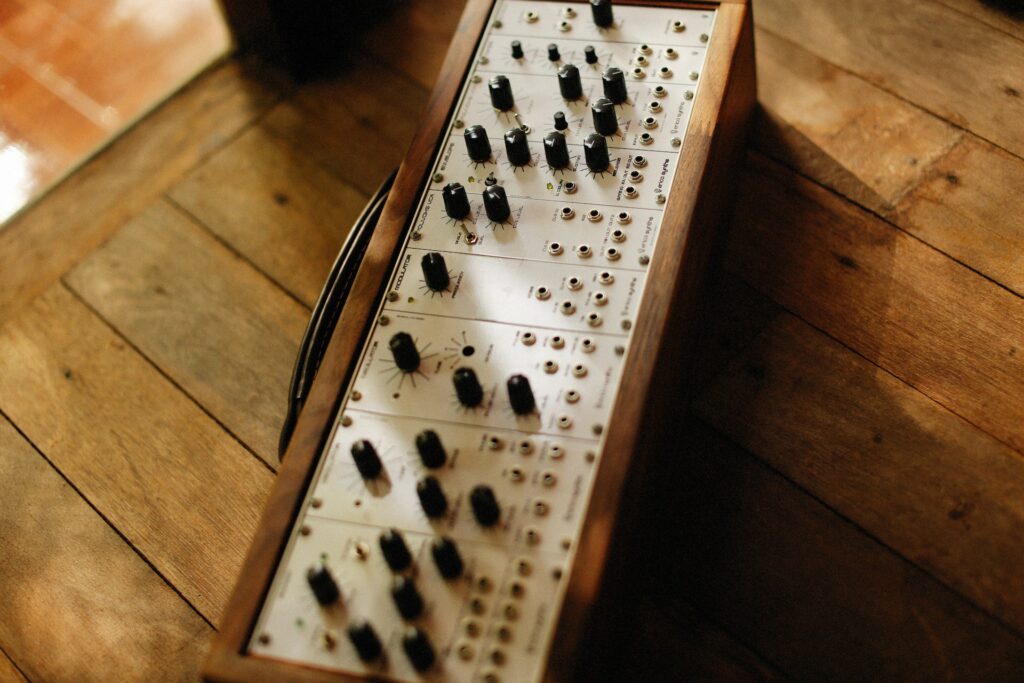
Virtual Analog
Digital synthesisers that mimic the analogue synthesizer’s workflow are known as virtual analogue (VA) synthesisers. The Minimoog, Odyssey, Prophet-5, and other popular synths from the 1970s are examples of traditional subtractive synthesis architectures that they often emulate. In order to deliver a user experience and sound close to vintage analogue synths with the benefits of digital synths: polyphony, pre-set memory, a smaller footprint, and a generally lower price, VA synths use digital simulations of oscillators, filters, amplifiers, etc.
The Nord Lead, Access Virus, Waldorf Q, Oberheim OB-12, Korg MS-2000, Alesis Ion, Yamaha AN-1x, and countless other models are examples of classic VAs. The Modor NF-1, ASM Hydrasynth, and Waldorf Blofeld are just a few instances of how intriguing and different contemporary VA approaches may be. Of course, many VAs are still in use. Alternatively, Roland’s Boutique series, which includes VA realisations of several of their renowned synthesisers, is a good option for people seeking vintage synth processes at an affordable price (including the SH-01A and JU-06A).
Hybrid
Despite having their beginnings in the 1970s and 1980s, hybrid synthesisers have become more widespread in the previous ten years. When an instrument is referred to as “hybrid,” it typically means that it combines analogue and digital parts, hopefully delivering some of the best features of both worlds. Hybrid synthesisers can operate in a wide variety of ways because the phrase normally denotes that some components of the synthesiser are digital and some are analogue.
For example, a popular setup is for a synth’s oscillators to be digital and then processed by an analogue filter, giving the oscillator performance the clean, dependable, and rich, deep coloration that is normally associated with an analogue filter. Both analogue and digital sound creation may be options on other instruments. Other instruments may retain a large portion of their analogue audio line while adding more options for modulation and performance control, or they may simply take advantage of the options afforded by integrating digital control.
What are the benefits of a synthesizer?
- Understanding of electricity and signal flow is developed through synthesiser learning and play.
- Synthesizer playing and learning fosters a deeper musical connection to tone and timbre.
- Synthesizer playing and learning improves one’s understanding of music and music technology.
- Learning and using a synthesiser gives you knowledge that may be used to other electronic instruments.
- Playing and learning the synthesiser helps with discipline and concentration.
- Building confidence through synthesiser learning and play.
- Synthesizer Playing & Learning Enhances Dexterity & Coordination.
- Playing and Learning Synthesizers Helps Memory.
- Synthesizer provides education and play offer a creative outlet.
- Synthesizer Playing & Learning Has Therapeutic Benefits.
Who can use a synthesizer?
The straightforward response is that synthesisers can produce sounds that other instruments cannot. Those who find this exciting use a synth. Synthesizers may produce a wide range of sounds, including bass, leads, pads, and percussion. They will alter the way you compose music and are helpful in the studio or on stage. While using pre-sets is totally acceptable, one of the primary benefits of using a synth is its enormous possibility for sound design.
Many musicians get a lot of satisfaction from being able to make distinctive patches. Not many genres have not utilised synthesisers in some capacity. But it’s safe to assume that they are most noticeable in electronic music. That includes subgenres including EDM, techno, house, trap, and dubstep, among others. However, before those genres existed, synths had a significant impact on the development of funk, fusion, jazz, rock, hip-hop, and other musical genres.
What are the alternatives to a synthesizer?
Modular synthesizers are good alternative to synths. What defines a modular synthesiser? A modular synthesiser is one that is made up of modules, or discrete, straightforward components that the user can choose from to build a system that suits their musical needs. Patch cables, which also carry audio signals and control voltages (analogue voltages that enable modules to control various elements of one another’s behaviour), are then used to link these modules to one another.
However, the term “modular” refers to a form element rather than a specific way of producing music. Like keyboards or desktop synths, modular synthesisers can be any mix of digital and analogue. The Moog, Buchla, ARP, Serge, and other systems from the 1960s and 1970s are the first instruments we may think of as modular synthesisers. They were primarily analogue instruments, just like the keyboard synths that came after them. However, contemporary modular synthesisers provide a design playground for both analogue and digital styles.
Best brands of a synthesizer?
Moog Music
Since the company was established in the early 1950s, the name Moog has come to be associated with top-notch synthesisers. Dr. Robert Moog, the creator of the renowned Moog Synthesizer and arguably the most significant pioneer in the field of synthesisers, left behind a legacy that the company is carrying on today (1964). The first synthesiser to be sold commercially was this one. By continuing such a tradition, Moog Music Inc. pushes the limits of sound performance, ergonomic designs, and usefulness in some of the best synthesisers available today.
Novation
The partnership between Novation and the maker of digital audio workstations Ableton is likely its most prominent feature. Both the controllers and the software, as well as the synthesisers, from Novation are fantastic. The sound quality and adaptability of the synthesisers Novation produces are outstanding. These synthesisers, which range from the MiniNova to the Summit, are made to enliven and explore musical possibilities. Since 1992, Novation has been active in the industry and can depend on a rich history. The organization’s innovative workforce builds on current successes to create future successes.
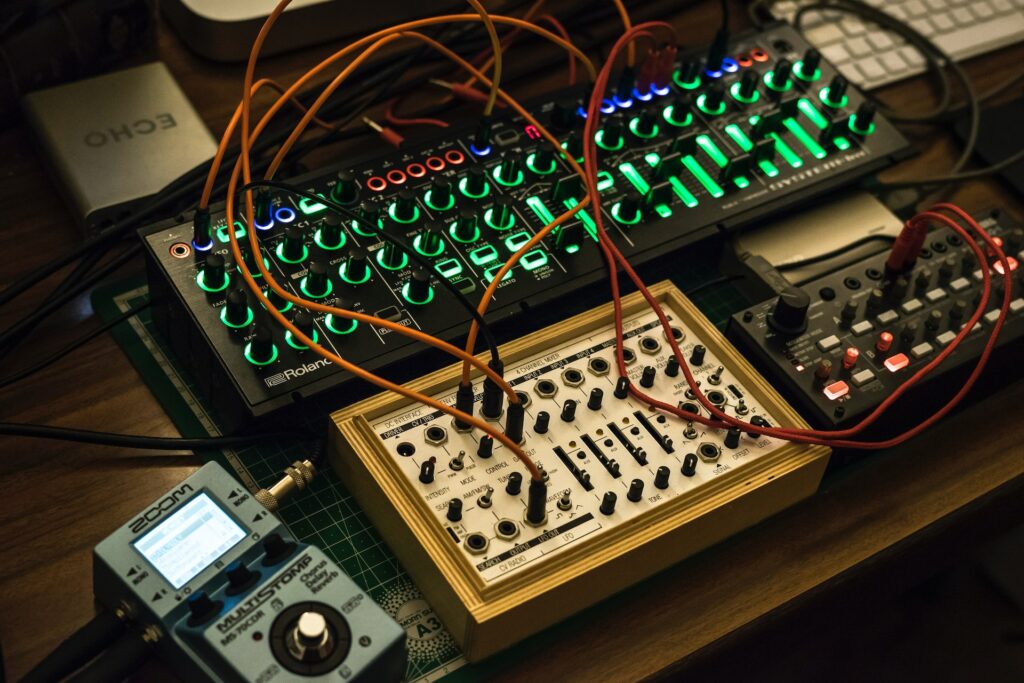
Yamaha
The oldest in business we will be talking about, is Yamaha. Yamaha has built a reputation as a fantastic synth creator with the launching of the expressive SY-1 in 1974. With its GS-1 synthesiser, Yamaha also contributed to the 1980 release of the first-ever frequency modulation digital synth. Yamaha has produced some of the best hardware synths in the world ever since its beginning. Yamaha has the ideal device that will undoubtedly satisfy all your synthesiser needs and exceed your desires.
Sequential
Sequential is a project by renowned synthesiser creator Dave Smith (of Dave Smith Instruments). Dave worked in R&D for both Yamaha and Korg, and he made a substantial contribution to the creation of MIDI. Sequential synthesisers provide excellent sound quality and usefulness because of this experience. The Prophet-5, introduced in 1977, was both the first musical instrument with an incorporated computer and the first completely programmable polyphonic synth (containing 5 voices).
The company has now grown to be a leading name in synth design. In 1974, Dave Smith founded Sequential in San Francisco, California, under the name “Sequential Circuits.” The business shut down in 1987, and Yamaha Corporation bought it. In 2002, Dave Smith went on to found Dave Smith Instruments. In 2015, Yamaha gave Dave Smith Instruments the Sequential Circuits trademark back, and in 2018, Dave Smith Instruments changed its name to Sequential.
Recommendation
Novation Peak:
Peak is one of Novation’s flagship synths and was created in collaboration with Chris Hugget. Peak is a monotimbral, 8-voice polyphonic, 24-‘Oxford’ oscillator synthesiser that primarily uses wavetables and very high-resolution anti-aliasing digital oscillators (NCOs) as its sound sources. Each of the three oscillators onboard provides the typical analogue waveforms (the saw has a density mode, giving you a “supersaw” mode), in addition to 17 wavetables that provide a wide variety of tonal options. Peak offers a tonne of sonic sculpting choices, a distinctive, expansive tone palette that works with all electronic music genres, and a tonne of hands-on control. Additionally, it is priced affordably and well-built. Congratulations to Novation on a fantastic device!
Specifications: – Analogue/digital synthesiser
- 8 voices in polyphony
- Keyboard: None
- Sequencer: No
- Effects: Chorus, chorus delay, reverb, and analogue distortion
- MIDI I/O: In, Out, Through
- Connectivity includes two pedal inputs, a CV in, left- and right-audio outs, headphones, and USB (MIDI).
- Electrical power
- Novation MiniNova Analogue Modelling Compact 37 Mini-key Synth – Tough, compact, powerful mini-synth with pitch-correcting effect vocoder, 256 onboard sounds and five effects per voice layering
- Make Huge Sounds- Create deep, gritty bass, soaring leads, lush pads, and vintage sounds with up to 18 voices and powerful effects.
- Built By a Legend- MiniNova’s synth engine was conceived, shaped, and refined by British synth legend Chris Huggett and has his five decades of passion, experience, and expertise behind it.
Final Words
Synthesizers are excellent musical instruments that help you travel in the most satisfying music-making process. But buying the first piece of modular musical gear can be a daunting task and we hope our guide helps you in making your first decision the best and helps you to invest in the most efficient music synthesizer.
Frequently Asked Questions (FAQs)
What are the advantages of Analog synths?
- Characterized by a “warm,” instantaneous sound, frequently the result of unusual quirks in electronic parts/ circuits.
- No sample rate or bit depth restrictions for sounds
- Has an infinite resolution.
- Results in no “zippering” sound and extremely fast tactile response.
- Has 1 knob for each function, making sound modification simple & easy.
What are the cons of Analog synths?
- Often concentrate on a narrow range of tones.
- Tuning on antique instruments can be unpredictable.
- More expensive than digital synths with comparable capabilities.
- Since the number of components directly affects sound production, more complex instruments may need a larger form factor.
- Without a digital control system in place, pre-set memory may not be an option.
What are the pros of Digital Synths?
- Can provide a far greater variety of audio methods.
- More cutting-edge methods of sound generation
- Control may be enabled by digital technology.
- Has preloaded memory.
- Less expensive
- Form factors can vary greatly; even tiny instruments have a lot of power.
What are granular synths?
It is sample-based, and instead of starting a full sample, it only starts a few fragments that play repeatedly. It is excellent for creating intriguing textures and has the potential to produce unexpected effects.
What is the origin of synths?
Now that you know the basics of what a synthesizer is, it makes sense to learn how it all got started. Despite odd instruments like the theremin and early synths being around in the 1950s, it wasn’t until 1970 that we first saw a synth in the shape we now associate with it.


